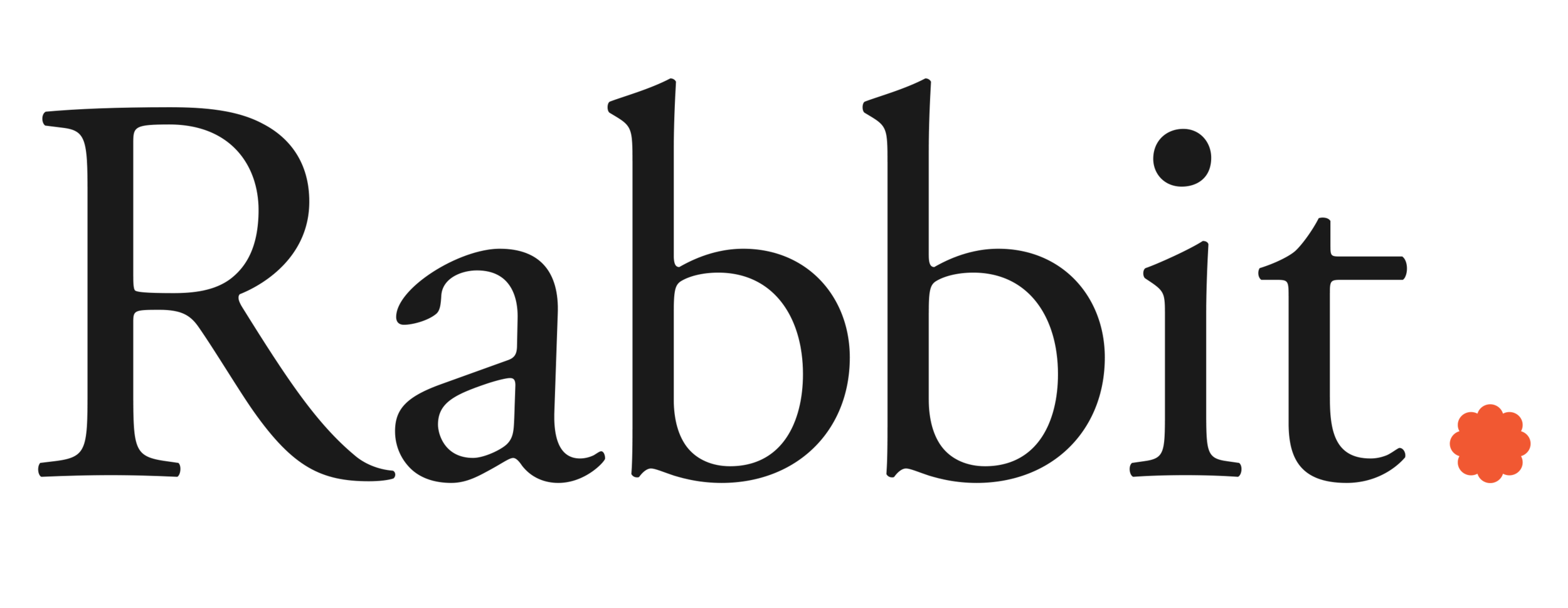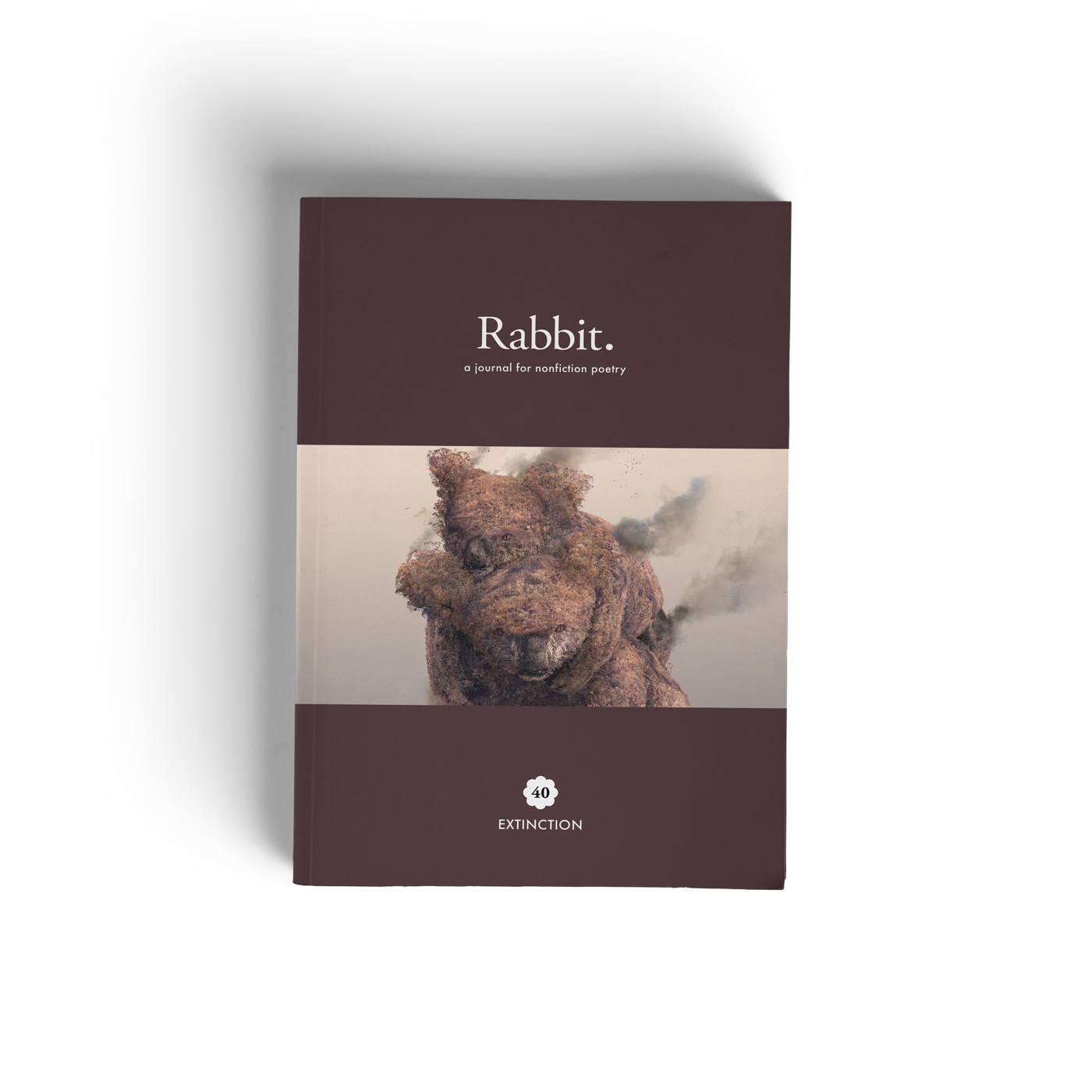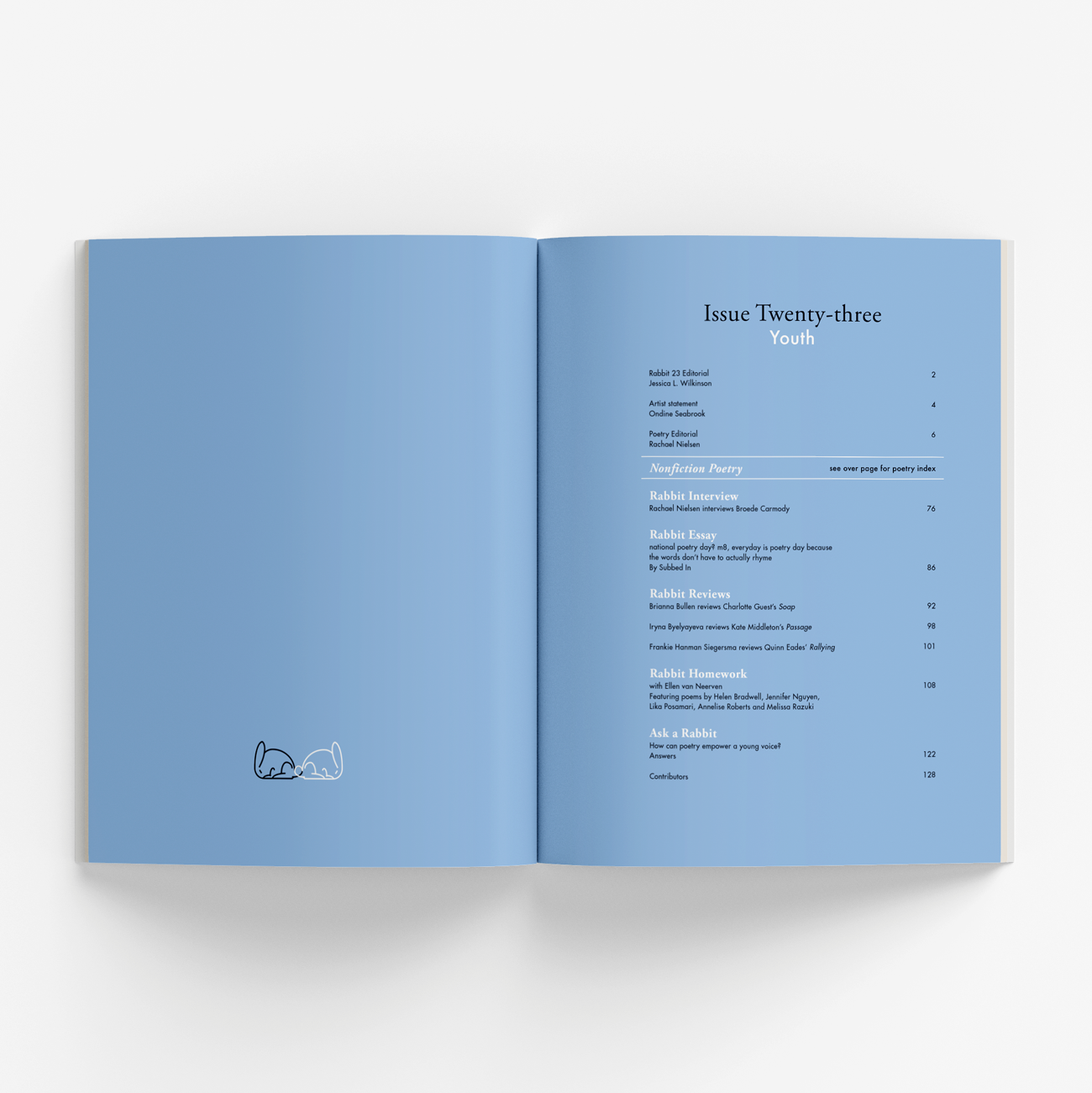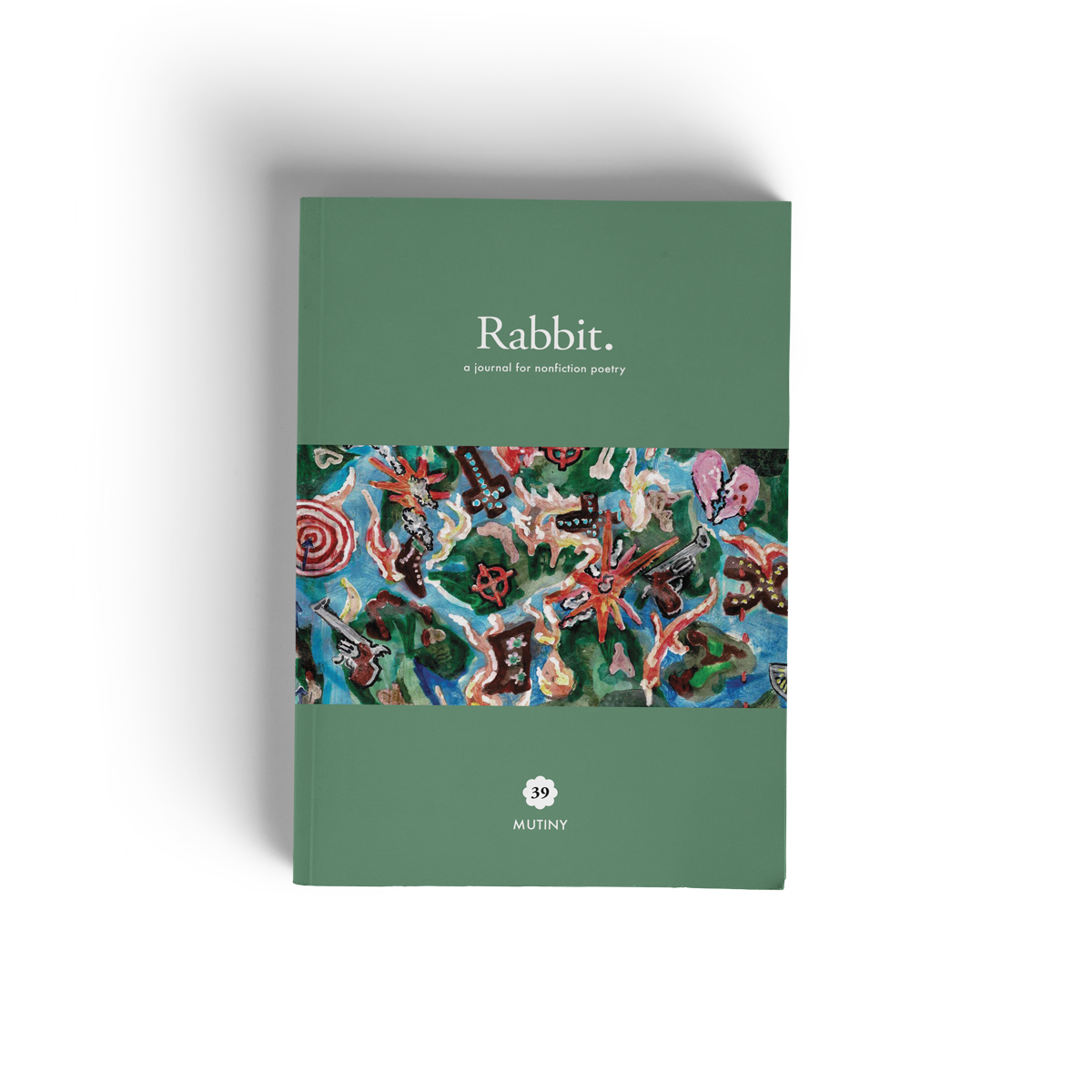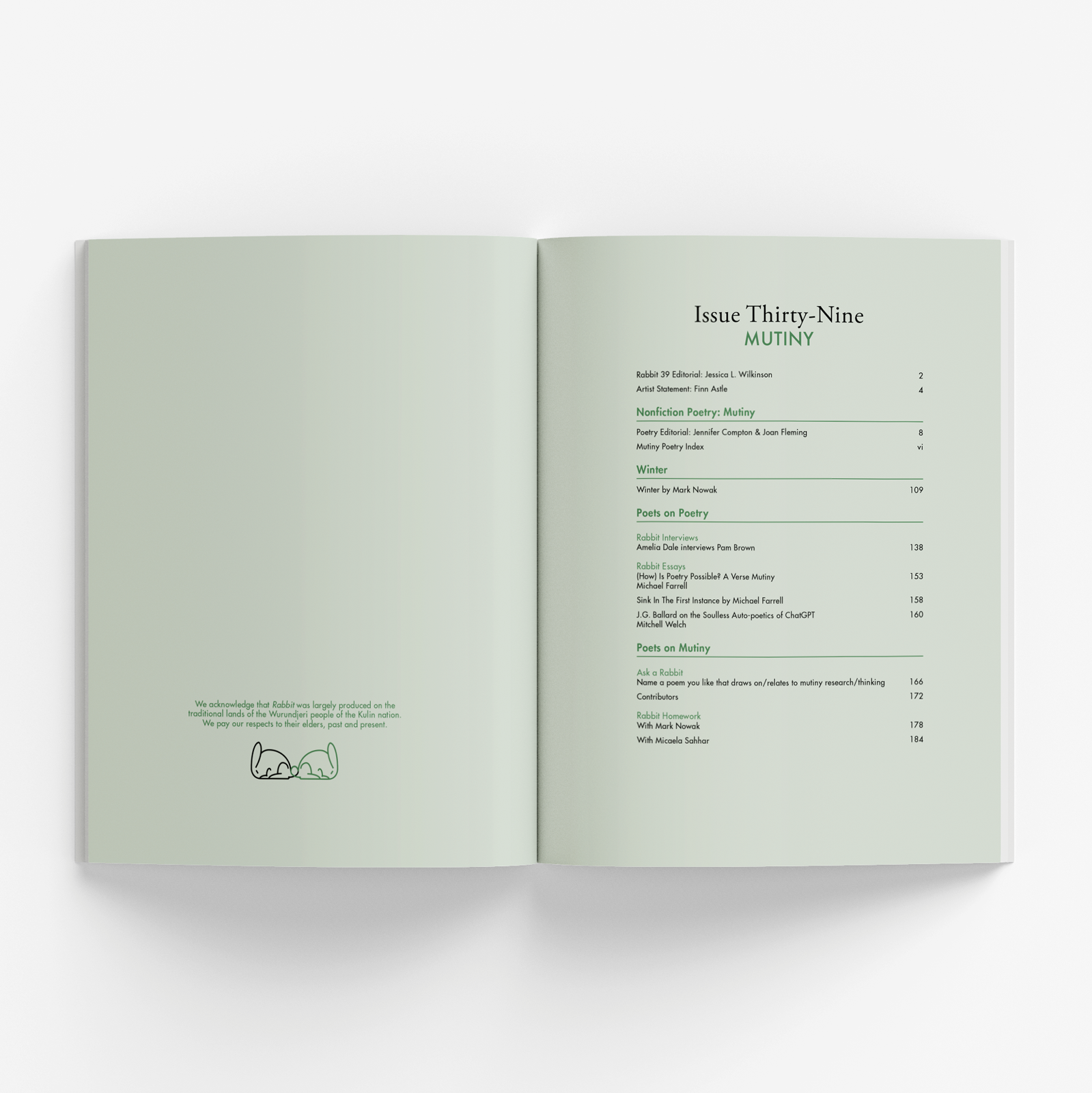RABBIT 35 – Architecture


RABBIT 35 – Architecture
‘Poets, of course, are highly attuned to the powers of juxtaposition, how the building blocks of a poem (words, lines, stanzas, space) can be intentionally drawn together to productively rub against one another.’
Architect Ludwig Mies van der Rohe once wrote that ‘Architecture starts when you carefully put two bricks together.’ I am not well versed in architectural principles, but this definition seems sensible, and I appreciate his inclusion of the word carefully—it reminds me that there should be a commitment and purpose behind any poiesis, or ‘making’. A definition of poetry might proceed similarly: ‘A poem starts when you carefully put two words together’. Poets, of course, are highly attuned to the powers of juxtaposition, how the building blocks of a poem (words, lines, stanzas, space) can be intentionally drawn together to productively rub against one another. This reminds me of a tattoo I saw on someone’s forearm several years ago, which said ‘wolves evolve’. I asked the owner of the arm what inspired the tattoo, and he said that it was the final line of Christian Bök’s poem ‘Vowels’. ‘Wolves evolve’ could almost be a poem in itself—that combination of syllables rolls around the mouth and tongue and reverberates in the ear; it activates our imaginations as we move beyond the literal (e.g. species evolution) to the metaphorical (foreshadowing something sinister, perhaps). The numerous lines that precede that one in the poem ‘Vowels’—lines that didn’t make the cut for tattoo rendering—would inspire additional interpretations of ‘wolves evolve’, too.
This brings me to another similarity between architecture and poetry, as suggested by Matthew Zapruder in his book Why Poetry: ‘A poem, literally, makes a space to move through.’ I have quoted this often and love its simplicity. Poems are like buildings in that we can (generally speaking) enter their structures and move around in our own, singular way; how the poem or building serves us is a matter of how we choose to ‘move’ through it. Yet Zapruder further writes that poems ‘are imaginative structures built out of words, ones that any reader can enter’ (my emphasis). In noting that‘any reader’ can enter a poem, he draws attention to a sense of sovereignty that poetry affords, and which is not afforded by most literal, built spaces in the world (obstructed as they are by the consequences of property, commerce, hierarchy, access, etc.). This sense of ‘freedom’ and ‘enlivenment’ that Zapruder associates with the poem is an idea beautifully captured in my favourite lines by Emily Dickinson: ‘I dwell in Possibility— / A fairer House than Prose— / More numerous of Windows— / Superior—for Doors—’. Dickinson makes me consider not only the ways in which we can move about and around a poem, but also how a poem can open—gently or radically—onto unexpected planes. A poem, in this sense, might be a kind of speculative architecture.
Thanks are heartily extended to our guest poetry editor, Ella Jeffery, for undertaking the always difficult task of selecting and curating a wonderful sequence of ‘architecture’ poems from the long list of submissions. Thanks also to Rabbit’s hard-working sub-editors, and to our contributors, sup- porters and readers. I do hope you enjoy roaming the strange architectural spaces offered within these pages.
*
When we began to compile the contents for this issue, the poetry community was shocked to hear of the sudden passing of Melbourne-based poet Jordie Albiston. I feel this loss deeply and personally. It is a loss for Rabbit, too. Perhaps Rabbit would not exist if it were not for Jordie’s documentary poetry, and what it inspired in me personally as a poet, scholar and editor. I have mentioned numerous times (in essays, interviews, scholarship) the impact that her book The Hanging of Jean Lee had on me as a young poet and university student. It was the first time I read poetry that I found genuinely interesting and inspiring; Jean Lee made me think about what poetry might ‘do’ to the fields of history and biography, how it might incorporate or extend ‘facts’. I was delighted by Dave Drayton’s perceptive analysis, in a review of two books in the Rabbit Poets Series a few years back: ‘a line can be traced from the early impact of Albiston’s book, to the journal [Rabbit], and on to the fledgling Rabbit Poets Series, which began with Albiston’s XIII Poems in 2013.’ In fact, so high was my regard for Jordie and her work that I started the offshoot Rabbit Poets Series for single-author collections because she mentioned that she had a short manuscript to place somewhere. (For anyone interested in reading XIII Poems, we have made the book available to all for free download via our website.)
As I am reflecting on Jordie’s work now, I think about her as poet-architect—how her books of poetry frequently reflected a structural conceit. Reading her poems, one can easily discern how every word on the page has been carefully selected and placed on its line; how every poem is a symmetrical and unified entity. The Book of Ethel, for instance, a sort of ‘poetic biography’ of the author’s maternal great-grandmother, is constituted of a series of poems that are ‘perfect squares’—7 lines of 7 syllables each. Ethel died in 1949 at the age of 77, which perhaps influenced these numerical specifications, although any explanation is beside the point. In an interview for Rabbit, Jordie stated that ‘there was a kind of crystalline inner shape that drew me to work with sevens’ and that ‘I love the idea of pitting the arbitrary against the fixed’. Jordie found doors and windows—liberty and energy—in constraints.
The poem that immediately follows this editorial was written by Jordie’s husband—musician and artist Andy Szikla. I asked him if we might share it with Rabbit readers as a tribute to Jordie (it has an unexpected synergy, too, with the Architecture theme). Andy generously agreed. I close this editorial, then, with a fond farewell to Jordie, who inspired me—and so many others—to keep writing and exploring poetry, its endless planes.
Contents
Rabbit 35 Editorial — Jessica L. Wilkinson
'the Jordie house' — Andy Szikla
Artist Statement — Emily Gordon
Nonfiction Poetry: Architecture
Poetry Editorial — Ella Jeffery
Poems
Bending the Frame — Jill Jones
Little Angkor Wat — Adam Aitken
sunflowers — James Lucas
Blueprint: Thorpe Street — Zenobia Frost
new world burdens — Brian Obiri-Asare
The Harbour — Ellen Shelley
Double Vanity — Rebecca Jessen
Pyramid — Damen O’Brien
“The most densely populated and busiest quartiers still lay over what had once been marsh.” -The Arcades Project (Romains) — Benjamin Landry
the crumbling house — Maya Hodge
Diotima the stoneworker — Josie/Jocelyn Deane
Lateral Thoughts — Ange Crawford
A Layering — Jake Goetz
Astronaut Syndrome — Sherry Luo
Arachnophobia — Danae Younge
Safe Passage — Elise O’Sullivan
At Fuxing Road — Aiden Heung
Domestic ardour — Lisa Collyer
renosaurus rex — joanne burns
A Lark: an ascendancy — Liam Ferney
Building Site — Mark O’Flynn
Ethics of Cloisters — Samantha Johnson
Duplex — Stuart Barnes
dark myrtle grove — Raphael Coronel
Federation Queen Anne sleepover — William Fox
First Nations Poetry: The Built Environment in Post-Invasion Australia
Poetry Editorial — Jeanine Leane
Poems
Songs You can’t hear — Timmah Ball
In Which I Am Homeless Without Ever Leaving Home — Beau Windon
Home — Paul Collis
Rabbit Interviews
Amelia Dale interviews Caren Florance
Rabbit Essays
Making Rooms: Emilie Collyer in conversation with Angela Costi
Soft and Against or Without — Elena Gomez
Rabbit Reviews
Dominique Hecq reviews Lizz Murphy’s The Wear of My Face
Lucas Smith reviews Adam Aitken’s Revenants
Michael J Leach reviews Andy Jackson’s Human Looking
Abigail Fisher reviews Alex Selenitsch’s Purgatorio Re-placed
Ask a Rabbit: How is a poem like a building?
Rabbit Homework with Alex Selenitsch
